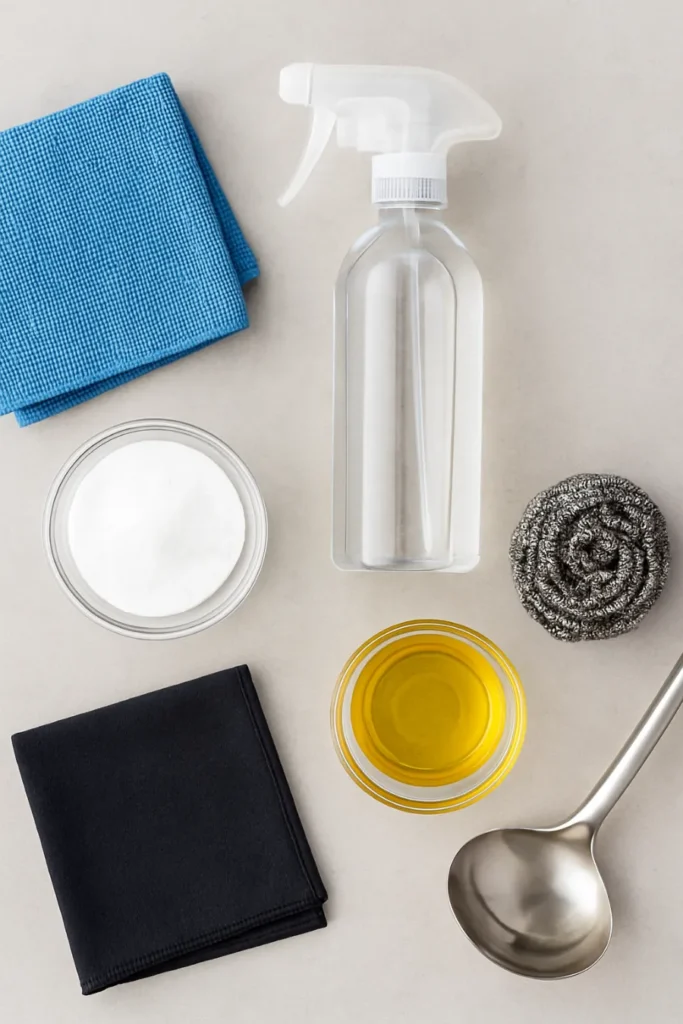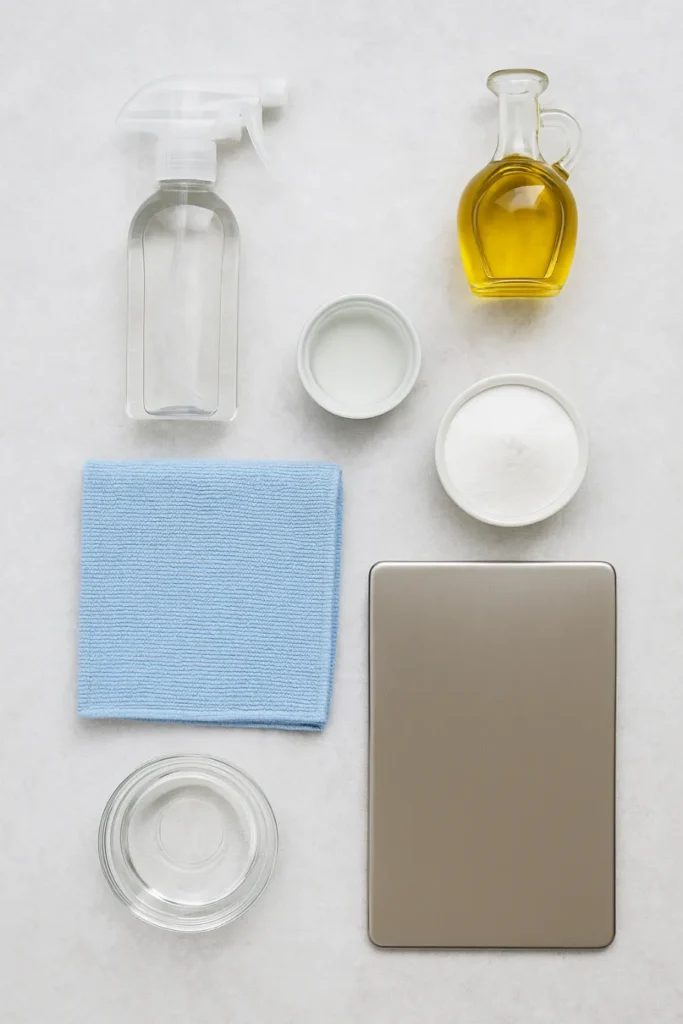Stainless steel is sleek, modern, and timeless—but let’s be honest, it can be a pain to keep spotless. If you own stainless steel appliances or cookware, you already know the frustration of fingerprints, water spots, and streaks that never seem to go away. The good news? Learning how to clean stainless steel is not nearly as complicated as it may seem. With the right methods, a few everyday ingredients, and a little know-how, you can restore that shiny, mirror-like finish without stress.
Let’s dive deep into everything you need to know about cleaning stainless steel—appliances, pans, and beyond.
Understanding Stainless Steel and Why It Gets Dirty

Stainless steel is a popular choice in kitchens for good reason—it’s durable, resists corrosion, and has a polished look that never goes out of style. But despite its name, stainless steel isn’t truly “stainless.” The shiny surface attracts smudges, water spots, grease, and even rust stains if neglected.
One reason it shows dirt so easily is the finish itself. Stainless steel has a grain—a series of fine lines that run in a particular direction. When you wipe against the grain, streaks show up more clearly. Add fingerprints, cooking splatters, and hard water, and you’ve got the recipe for a less-than-sparkling surface.
There are also different finishes of stainless steel, from brushed to polished, which may react differently to certain cleaning methods. This is why one product may work wonders on your fridge but leave streaks on your oven door.
The Basics of Cleaning Stainless Steel
Before reaching for anything under the sink, it helps to master the basics of cleaning stainless steel.
- Clean with the grain: Always wipe in the direction of the steel’s grain. Going against it leaves streaks.
- Choose the right cloth: A clean microfiber cloth works best. Paper towels can scratch or leave lint behind.
- Avoid harsh chemicals: Chlorine bleach, ammonia, and abrasive powders can damage the protective finish. Stick to gentle solutions.
- Less is more: Often, warm water and a microfiber cloth are enough for routine cleaning. Save stronger cleaners for stubborn messes.
Common Mistakes to Avoid When Cleaning Stainless Steel
To keep your appliances and cookware safe, avoid these common cleaning pitfalls:
- Abrasive scrubbers: Steel wool, scouring pads, or stiff brushes will scratch the surface.
- Chlorine-based cleaners: These can cause pitting or permanent stains.
- Oil-heavy polishes: While oils make the surface shiny at first, they attract dust and fingerprints over time.
- Hard water: Tap water with high mineral content leaves spots. Always dry surfaces thoroughly after cleaning.
Best At-Home Methods for Cleaning Stainless Steel

You don’t need expensive products to keep stainless steel spotless. Here are tried-and-true household methods:
Cleaning with Vinegar and Olive Oil
- Fill a spray bottle with white vinegar.
- Spray the surface generously.
- Wipe with a microfiber cloth, following the grain.
- Dip the cloth in a little olive oil and buff for shine.
This combo removes smudges while leaving a polished finish.
Cleaning with Dish Soap and Baby Oil
- Wash the surface with warm water and a drop of mild dish soap.
- Dry with a clean cloth.
- Add a few drops of baby oil to a microfiber towel and polish along the grain.
This method cuts grease and adds a sleek, fingerprint-resistant layer.
Cleaning with Club Soda
- Pour club soda into a spray bottle.
- Spray directly onto the stainless steel surface.
- Wipe with a clean microfiber cloth, going with the grain.
It’s a simple, chemical-free option that works well for everyday touch-ups.
Using Baking Soda for Stubborn Stains
- Sprinkle baking soda onto a damp sponge or cloth.
- Gently scrub stained areas in the direction of the grain.
- Rinse with warm water and dry thoroughly.
Baking soda is especially useful for removing discoloration or burnt spots on cookware.
Store-Bought Solutions for Cleaning Stainless Steel
If DIY isn’t your style, there are plenty of commercial cleaners designed for stainless steel.
- Stainless steel wipes: Convenient for quick touch-ups.
- Sprays and foams: Offer deep cleaning power for grease and tough stains.
- Powder cleaners (like Bar Keepers Friend): Great for cookware and stubborn residue, but should be used sparingly to avoid scratching.
When using store-bought solutions, always spray onto your cloth, not directly onto the appliance. This prevents overspray and uneven application.
How to Clean Stainless Steel Appliances
Appliances are usually the trickiest to keep spotless because they’re touched constantly. Here’s a step-by-step guide:
Everyday Cleaning
- Mix 1½ cups water with ½ teaspoon dish soap in a spray bottle.
- Spray the appliance lightly.
- Wipe in an “S” motion with a microfiber towel, following the grain.
- Rinse with a damp cloth.
- Dry thoroughly to prevent water spots.
Removing Hard Water Stains
- Soak a cloth in vinegar and press it onto the stain for 5–10 minutes.
- Wipe clean, rinse with soapy water, and dry thoroughly.
Removing Rust Stains
- Mix baking soda with a little water to form a paste.
- Rub gently on the rust stain.
- Rinse with soapy water and dry.
Cleaning with a Steamer
For hardened food particles, use a handheld steamer. Glide over the surface, then wipe dry with a microfiber cloth.
How to Clean Stainless Steel Cookware and Pans
Cookware needs a slightly different approach. Here’s how to restore your pans to their shiny, brand-new look:
Everyday Cleaning
- Wash with warm soapy water and a non-abrasive sponge.
- Avoid the dishwasher when possible, even if labeled dishwasher-safe.
Removing Burnt-On Food
- Fill the pan with water and a spoonful of baking soda.
- Bring to a boil, simmer, then scrape gently with a wooden spoon.
- Wash and dry as usual.
Fixing Discoloration (Rainbow Stains)
- Wipe with vinegar using a soft cloth.
- Rinse and dry thoroughly.
- For stubborn spots, simmer a vinegar-and-water mixture in the pan.
Preventing Water Spots
- Dry pans immediately after washing.
- Sprinkle a little baking soda and wipe with a damp sponge if spots appear.
Maintenance Tips to Keep Stainless Steel Looking New

- Clean regularly: A quick wipe every few days keeps buildup away.
- Polish occasionally: A small dab of olive oil or a store-bought polish maintains the shine.
- Prevent scratches: Avoid stacking cookware directly; use pan protectors or paper towels.
- Be mindful with heat: Overheating cookware can cause rainbow discoloration.
Final Thoughts
Stainless steel may seem high-maintenance, but with the right approach, keeping it clean is simple. Whether it’s your fridge, dishwasher, or cookware, the key is consistency: wipe with the grain, avoid harsh chemicals, and dry thoroughly. With these strategies, you’ll never dread fingerprints and streaks again—and your kitchen will always sparkle.












